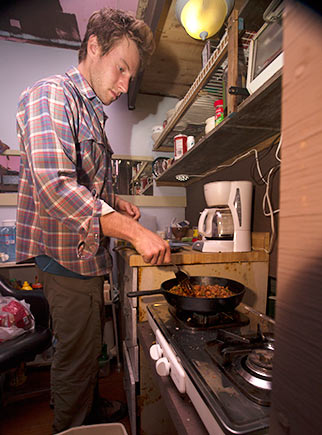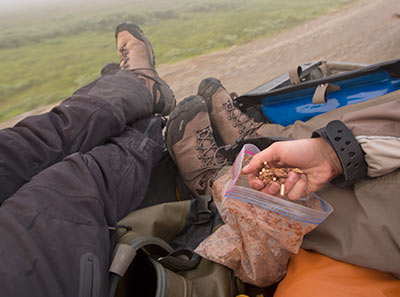Nutrition: Fueling the Fires Within
 Cold weather and water present a variety of challenges to boaters who want to extend their season into fall, winter and spring. See “Cold Water Layering” for apparel choices appropriate for the season and your type of boating. If you need help in choosing the best pieces of your protective layering system, reach out.
Cold weather and water present a variety of challenges to boaters who want to extend their season into fall, winter and spring. See “Cold Water Layering” for apparel choices appropriate for the season and your type of boating. If you need help in choosing the best pieces of your protective layering system, reach out.
Body Mechanisms
- Every bit as important as the right apparel and gear for your safety and protection are proper nutrition and hydration to keep your body fueled and warm.
- Your body produces heat in three ways: the metabolism of food, shivering and exercise. The “thermostat” that regulates your heating and cooling systems is located in the part of the brain called the hypothalamus. The sensors that feed information to the hypothalamus are located in your skin and body core.
Metabolism
- Your baseline heat production from digestion and metabolism of food goes on around the clock with most of the heat being produced by the internal organs in your body core.
- When you get chilled, the internal sensors rev up your metabolic rate, as much as doubling it.
- When carbohydrates (grains, fruit, some milk groups, etc) are ingested they’re converted into sugars in the stomach, small intestine and liver. Those sugars, in the final form of glucose, enter the bloodstream and are transported to all the body’s organs and tissues to provide energy for the body’s functions.
- If the body doesn’t need all that glucose for energy, it stores extra glucose in the muscles and liver in the form of glycogen. That stored glycogen is the “fuel” needed for a quick crank-up of heat. When the glycogen stores are full, extra glucose is stored as fat, which is not as quickly available to produce energy.
- Glycogen stores are somewhat limited, only about 2000 calories worth, so especially in cold weather it’s important to regularly replenish calories used.
Shivering Response
- When your core temperature drops 2–3°F, your thermostat triggers that uncontrolled contraction and relaxation of muscles that we call “shivering.” It can increase your baseline heat production five to seven times. It too depends on your body’s supply of glycogen to fuel this heat production.
Exercise
- The most efficient way your body produces heat is by voluntary exercise, a heating process up to 15 times more abundant than your baseline heat production.
- Exercise is not only more efficient than shivering; it does useful work—like paddling or rowing, or in a survival situation, building a fire or an emergency shelter.
- Once again, you need that stored glycogen fuel to power your exercise activity.
Calorie Needs
- Cold weather itself doesn’t increase your body’s need for more food calories. However, some cold induced conditions necessitate more fuel intake.
- It takes a surprising amount of heat energy to warm the air you breathe in during activity in the cold. Heavier, more restrictive clothing causes you to burn more calories.
- As mentioned earlier, shivering and exercise draw down your glycogen reserves. Much of the research on calorie need in cold weather has been done by the military. Their studies show that soldiers operating in cold conditions require up to 40% more food calories than in temperate conditions.
Dehydration
 Surprisingly, dehydration is all too common in cold weather. Cold temperatures interfere with the proper metabolism of food and reduce your appetite. Dehydration impairs the shivering response and leads to lethargy and low energy levels.
Surprisingly, dehydration is all too common in cold weather. Cold temperatures interfere with the proper metabolism of food and reduce your appetite. Dehydration impairs the shivering response and leads to lethargy and low energy levels.- Cold also reduces your urge to drink fluids. We often avoid drinking because increased clothing layers make it more difficult to pee. Dry winter air pulls a lot of water out of our body. As we breathe, water humidifies the air going into our lungs and is then exhaled (hence, “seeing your breath”).
- Another form of fluid loss in cold weather is “cold-induced diuresis.” When you get cold, your heat regulatory system constricts blood vessels in your extremities to protect the body core from heat loss. With this shrinkage of volume of the vascular system, the signal goes to the brain that there’s more blood than the body needs. The brain tells your kidneys that they need to get rid of some water. This explains your needing to pee more often when out in the cold.
- See “Boaters and Dehydration” for more information on the causes, effects and how to avoid dehydration.
So, you can see the importance of good nutrition and hydration to keep your body in the most efficient and comfortable condition for high performance in cold weather. Here are some dos and don’ts to help you stay warm and safe; so you can get the maximum enjoyment during cold season boating:
Dos and Don’ts for Proper Nutrition and Hydration
- Do eat nutritious high-carbohydrate foods prior to boating or other exercise in cold weather. High carb intake one to four hours before exercise will restore liver glycogen. To get glycogen to the muscles, the carbs need to be eaten several hours earlier.
- Do continue to eat snacks high in carbohydrates throughout the day. There are numerous energy bars, gels, and granola bars on the market. Dried fruit, trail mix, crackers, and cookies are good sources. Choose sources high in complex carbohydrates and low in simple sugars for a steadier supply of energy. Simple sugars provide a quick spike in energy, with a corresponding dip or crash.
- Do drink lots of fluids during the day. Drink small amounts often. Drinking a large volume in a short amount of time is more than your body can absorb, so most of it just passes out through the kidneys. Some sources say consume about 5 ounces every 20 minutes. As long as you’re eating a well-balanced diet, plain water is sufficient. During prolonged heavy outdoor exercise you may want to supplement an electrolyte/carbohydrate replacement sports beverage.
- Do try to consume warm foods and beverages when out in the cold. Your body has to use energy to warm cold food and drinks, creating a chilling effect. Warm stuff is also a great psychological morale booster.
- Do moderate your caffeine consumption. Caffeine is a diuretic; it draws water out of your system. Hot cocoa is a great winter drink, as well as hot cider and soup.
- Do replenish your energy supplies at the end of a day’s boating. Take in some good carbohydrates and a bit of protein within two hours of hitting the beach. Eating some food before you go to bed will help you stay warm when you’re curled up in your sleeping bag.
- Don’t practice any restrictive diets during times when you’ll be spending significant times outdoors. You need to keep your body supplied with lots of good fuel for cold-weather comfort.
- Don’t consume excessive alcohol when out in the cold. It may feel like it “warms” you up, but it actually causes your peripheral blood vessels to dilate, bringing more blood to your body’s surface and radiating your heat out into the cold.
- Don’t adopt a high-fat diet right before going on a boating trip. Yes, it works for the Eskimo and other northern natives, but it takes at least a couple of months for your body’s metabolism to adapt to the diet and give you the glycogen fuel you need for those winter conditions.
Modern layering, insulating and technical outer garments have opened up the entire year for boating and enjoying the great outdoors. Dress right, eat well, drink often and enjoy some great cold weather boating!